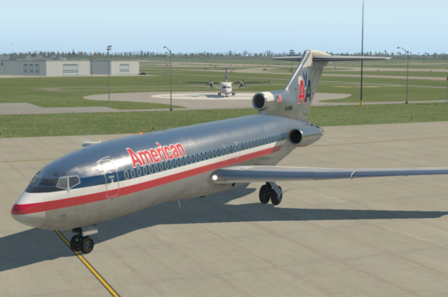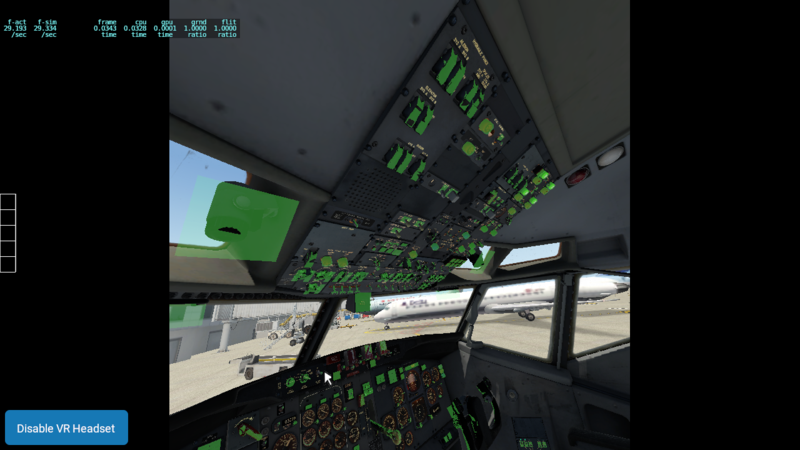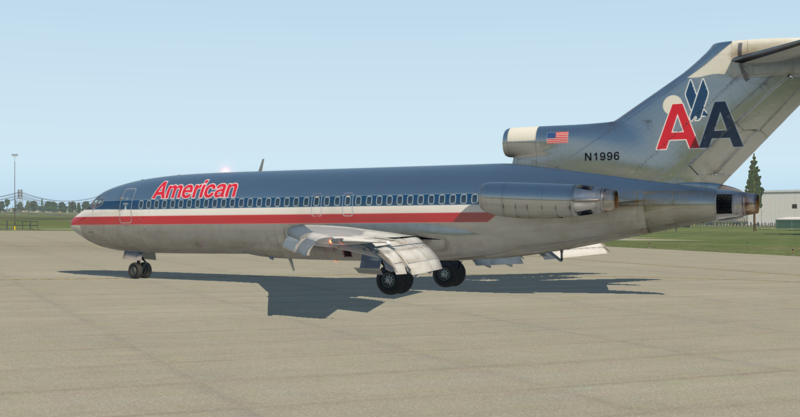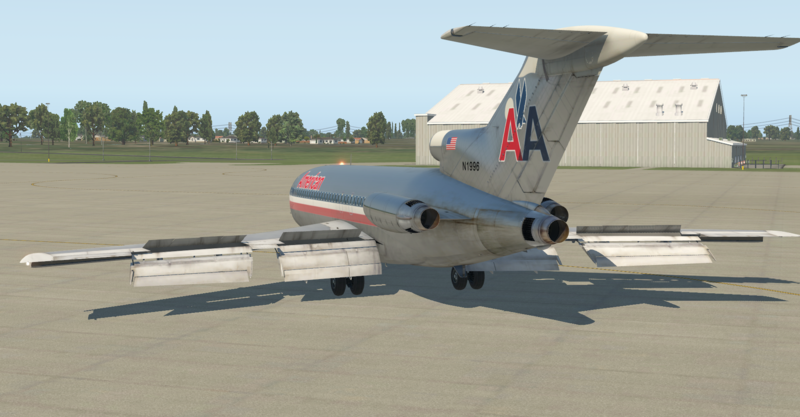Boeing 727
For this airplane shown in original American Airlines colors--and which is well behaved in flight--the Bravo quadrant is reduced to three power levers, along with the other usual controls. The airplane steers on the ground with the use of the captain's tiller, and that function is assigned to a rotary knob on the X56 quadrant (the tiller in VR moves as commanded by the X56). There is no audio in any video.
sunset VR view at 35,000 ft. (FL 350) gate arrival Green highlighted items are all functional and can be manipulated
by mouse or flight control--an unusually high number.
Instrument Landing System (ILS) approach at weather minimums.
In the video you'll notice two things: at 200' above ground level (AGL) the autopilot is disengaged (red flashing light left of the attitude indicator), and at 100' AGL throttles go to idle.
In this 727 there are autopilot (radar altimeter) audio call-outs of altitude for landing, and audio call-outs of airspeeds (V1 and "rotate") during takeoff.
The video to the left demonstrates an emergency descent from FL320 (32,000 ft.). Such a descent is most often required when there is a compromise of the pressure vessel (loss of cabin pressure) during which passenger oxygen masks are deployed and the flight crew dons oxygen masks. There may be other situations requiring an emergency descent, and the goal is to rapidly descend to an altitude--hopefully available--at which all can breath normally (14,000 ft. or below is satisfactory (except for heavy smokers)).
Power levers are reduced to idle, speed brakes are deployed, the autopilot is usually disengaged, and a 15-20 degree descending pitch attitude is attained. On some airplanes the autopilot commands these actions since there may be only a small margin between maximum operating Mach speed (Mmo) and stall speed making hand flying difficult.
In an earlier time a medium-to-steep bank was initiated--and was standard training--to maintain positive G while the pitch attitude was achieved, and to reduce the vertical component of lift and add wing loading, both of which increase descent rate. The resulting turn also got the airplane off of a published route in the event another airplane was below. The hazard was that if the turn and nose-down pitch got out of control another precise maneuver was required to terminate a "graveyard spiral," something that is especially demanding when in clouds, and is itself an emergency training maneuver termed "recovery from unusual attitudes." This video demonstrates that turn even though it is not widely employed today. Also demonstrated is lowering of the landing gear to increase drag and descent rate (in the case that speed during descent and/or at deployment does not exceed limits (Vle or Vlo.)
From FL320 a 12 degree nose-down pitch attitude resulted in a 12,000 fpm descent at about .75 Mach. That descent rate will cause inner ear discomfort. (Normal is 500-1000 fpm climbing or descending).
:04 power levers to idle, spoilers/speed brakes deployed
:13 landing gear handle down to extend gear
:19 spoilers shown deployed
:31 gear extending
(descent continues as necessary to reach desired altitude)
:45 power up in recovery to level flight
:51 spoilers retracted
:56 gear handle up to retract landing gear
1:09 spoilers seen retracting
1:12 gear retracting
1:12 return to level flight
spoilers/speed brakes
flaps
slats







